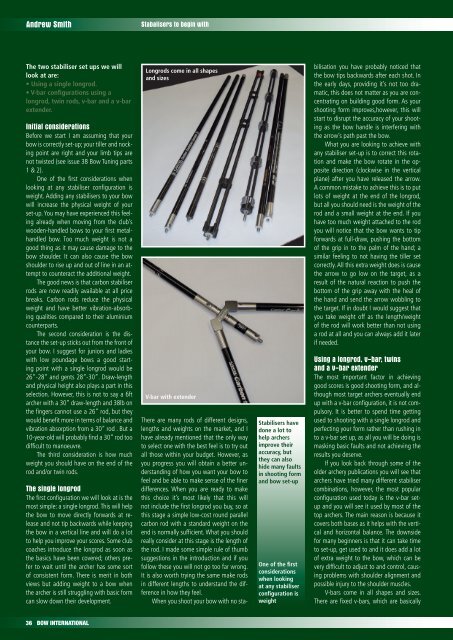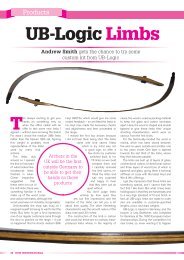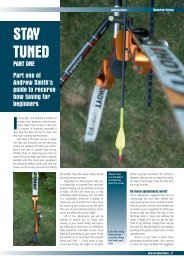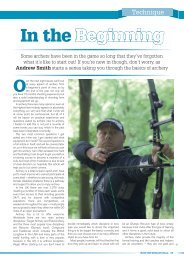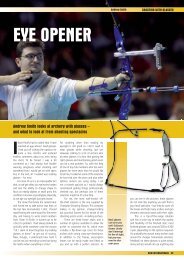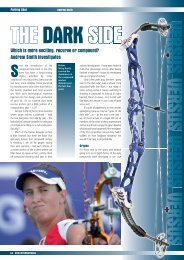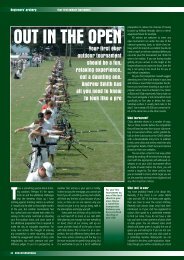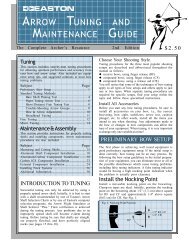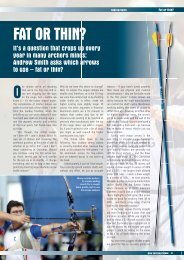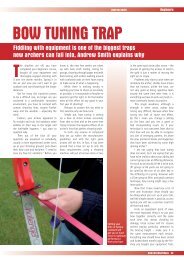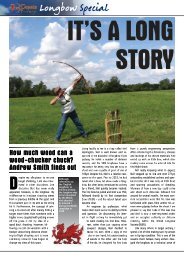Recurve Stabilisation - Perris Archery
Recurve Stabilisation - Perris Archery
Recurve Stabilisation - Perris Archery
You also want an ePaper? Increase the reach of your titles
YUMPU automatically turns print PDFs into web optimized ePapers that Google loves.
Andrew Smith<br />
The two stabiliser set ups we will<br />
look at are:<br />
• Using a single longrod.<br />
• V-bar configurations using a<br />
longrod, twin rods, v-bar and a v-bar<br />
extender.<br />
Initial considerations<br />
Before we start I am assuming that your<br />
bow is correctly set-up; your tiller and nocking<br />
point are right and your limb tips are<br />
not twisted (see issue 38 Bow Tuning parts<br />
1 & 2).<br />
One of the first considerations when<br />
looking at any stabiliser configuration is<br />
weight. Adding any stabilisers to your bow<br />
will increase the physical weight of your<br />
set-up. You may have experienced this feeling<br />
already when moving from the club’s<br />
wooden-handled bows to your first metalhandled<br />
bow. Too much weight is not a<br />
good thing as it may cause damage to the<br />
bow shoulder. It can also cause the bow<br />
shoulder to rise up and out of line in an attempt<br />
to counteract the additional weight.<br />
The good news is that carbon stabiliser<br />
rods are now readily available at all price<br />
breaks. Carbon rods reduce the physical<br />
weight and have better vibration-absorbing<br />
qualities compared to their aluminium<br />
counterparts.<br />
The second consideration is the distance<br />
the set-up sticks out from the front of<br />
your bow. I suggest for juniors and ladies<br />
with low poundage bows a good starting<br />
point with a single longrod would be<br />
26”-28” and gents 28”-30”. Draw-length<br />
and physical height also plays a part in this<br />
selection. However, this is not to say a 6ft<br />
archer with a 30” draw-length and 38lb on<br />
the fingers cannot use a 26” rod, but they<br />
would benefit more in terms of balance and<br />
vibration absorption from a 30” rod . But a<br />
10-year-old will probably find a 30” rod too<br />
difficult to manoeuvre.<br />
The third consideration is how much<br />
weight you should have on the end of the<br />
rod and/or twin rods.<br />
The single longrod<br />
The first configuration we will look at is the<br />
most simple: a single longrod. This will help<br />
the bow to move directly forwards at release<br />
and not tip backwards while keeping<br />
the bow in a vertical line and will do a lot<br />
to help you improve your scores. Some club<br />
coaches introduce the longrod as soon as<br />
the basics have been covered; others prefer<br />
to wait until the archer has some sort<br />
of consistent form. There is merit in both<br />
views but adding weight to a bow when<br />
the archer is still struggling with basic form<br />
can slow down their development.<br />
36 BOW INTERNATIONAL<br />
Stabalisers to begin with<br />
Longrods come in all shapes<br />
and sizes<br />
V-bar with extender<br />
There are many rods of different designs,<br />
lengths and weights on the market, and I<br />
have already mentioned that the only way<br />
to select one with the best feel is to try out<br />
all those within your budget. However, as<br />
you progress you will obtain a better understanding<br />
of how you want your bow to<br />
feel and be able to make sense of the finer<br />
differences. When you are ready to make<br />
this choice it’s most likely that this will<br />
not include the first longrod you buy, so at<br />
this stage a simple low-cost round parallel<br />
carbon rod with a standard weight on the<br />
end is normally sufficient. What you should<br />
really consider at this stage is the length of<br />
the rod. I made some simple rule of thumb<br />
suggestions in the introduction and if you<br />
follow these you will not go too far wrong.<br />
It is also worth trying the same make rods<br />
in different lengths to understand the difference<br />
in how they feel.<br />
When you shoot your bow with no sta-<br />
Stabilisers have<br />
done a lot to<br />
help archers<br />
improve their<br />
accuracy, but<br />
they can also<br />
hide many faults<br />
in shooting form<br />
and bow set-up<br />
One of the first<br />
considerations<br />
when looking<br />
at any stabiliser<br />
configuration is<br />
weight<br />
bilisation you have probably noticed that<br />
the bow tips backwards after each shot. In<br />
the early days, providing it’s not too dramatic,<br />
this does not matter as you are concentrating<br />
on building good form. As your<br />
shooting form improves,however, this will<br />
start to disrupt the accuracy of your shooting<br />
as the bow handle is interfering with<br />
the arrow’s path past the bow.<br />
What you are looking to achieve with<br />
any stabiliser set-up is to correct this rotation<br />
and make the bow rotate in the opposite<br />
direction (clockwise in the vertical<br />
plane) after you have released the arrow.<br />
A common mistake to achieve this is to put<br />
lots of weight at the end of the longrod,<br />
but all you should need is the weight of the<br />
rod and a small weight at the end. If you<br />
have too much weight attached to the rod<br />
you will notice that the bow wants to tip<br />
forwards at full-draw, pushing the bottom<br />
of the grip in to the palm of the hand; a<br />
similar feeling to not having the tiller set<br />
correctly. All this extra weight does is cause<br />
the arrow to go low on the target, as a<br />
result of the natural reaction to push the<br />
bottom of the grip away with the heal of<br />
the hand and send the arrow wobbling to<br />
the target. If in doubt I would suggest that<br />
you take weight off as the length/weight<br />
of the rod will work better than not using<br />
a rod at all and you can always add it later<br />
if needed.<br />
Using a longrod, v-bar, twins<br />
and a v-bar extender<br />
The most important factor in achieving<br />
good scores is good shooting form, and although<br />
most target archers eventually end<br />
up with a v-bar configuration, it is not compulsory.<br />
It is better to spend time getting<br />
used to shooting with a single longrod and<br />
perfecting your form rather than rushing in<br />
to a v-bar set up, as all you will be doing is<br />
masking basic faults and not achieving the<br />
results you deserve.<br />
If you look back through some of the<br />
older archery publications you will see that<br />
archers have tried many different stabiliser<br />
combinations, however, the most popular<br />
configuration used today is the v-bar setup<br />
and you will see it used by most of the<br />
top archers. The main reason is because it<br />
covers both bases as it helps with the vertical<br />
and horizontal balance. The downside<br />
for many beginners is that it can take time<br />
to set-up, get used to and it does add a lot<br />
of extra weight to the bow, which can be<br />
very difficult to adjust to and control, causing<br />
problems with shoulder alignment and<br />
possible injury to the shoulder muscles.<br />
V-bars come in all shapes and sizes.<br />
There are fixed v-bars, which are basically


